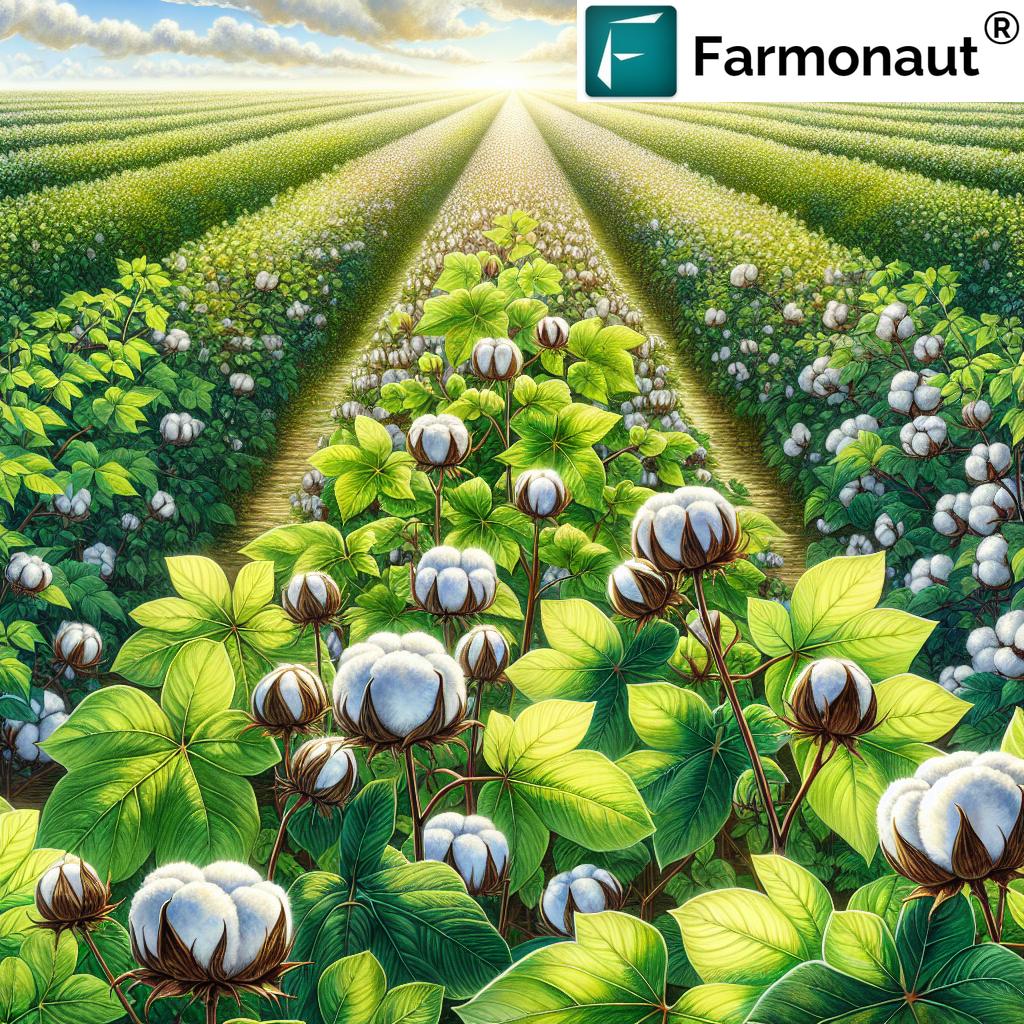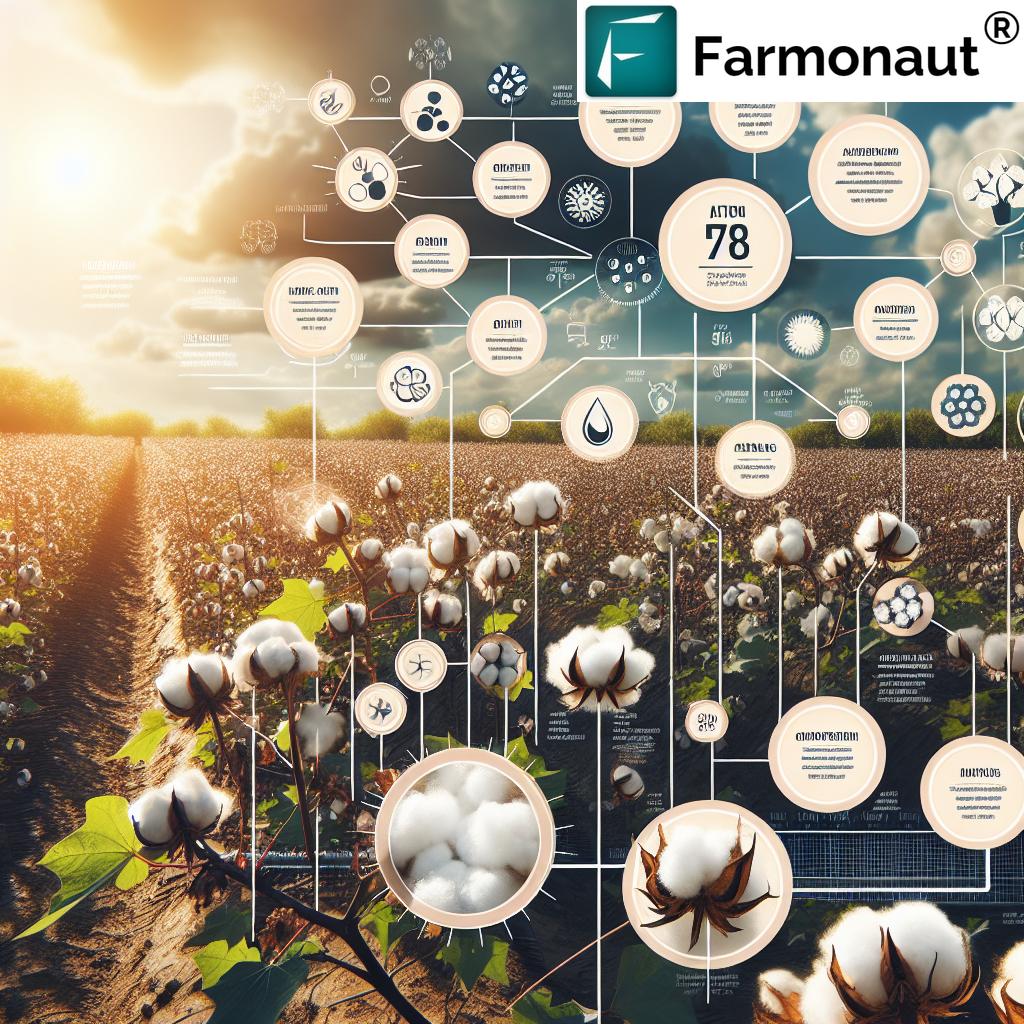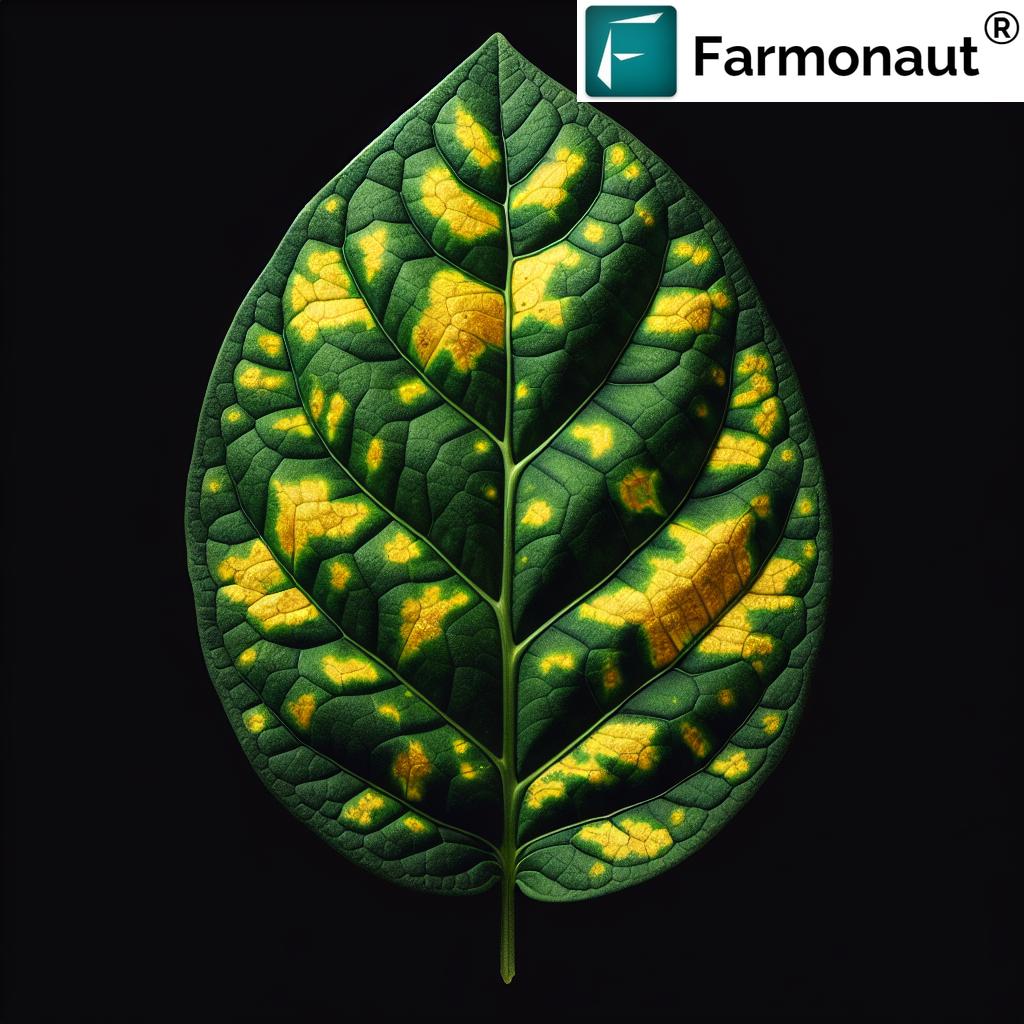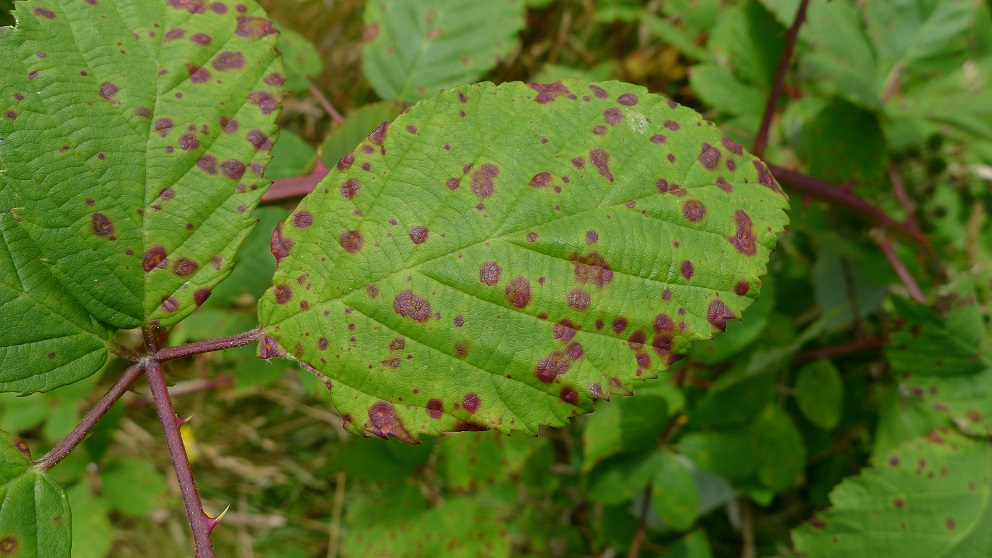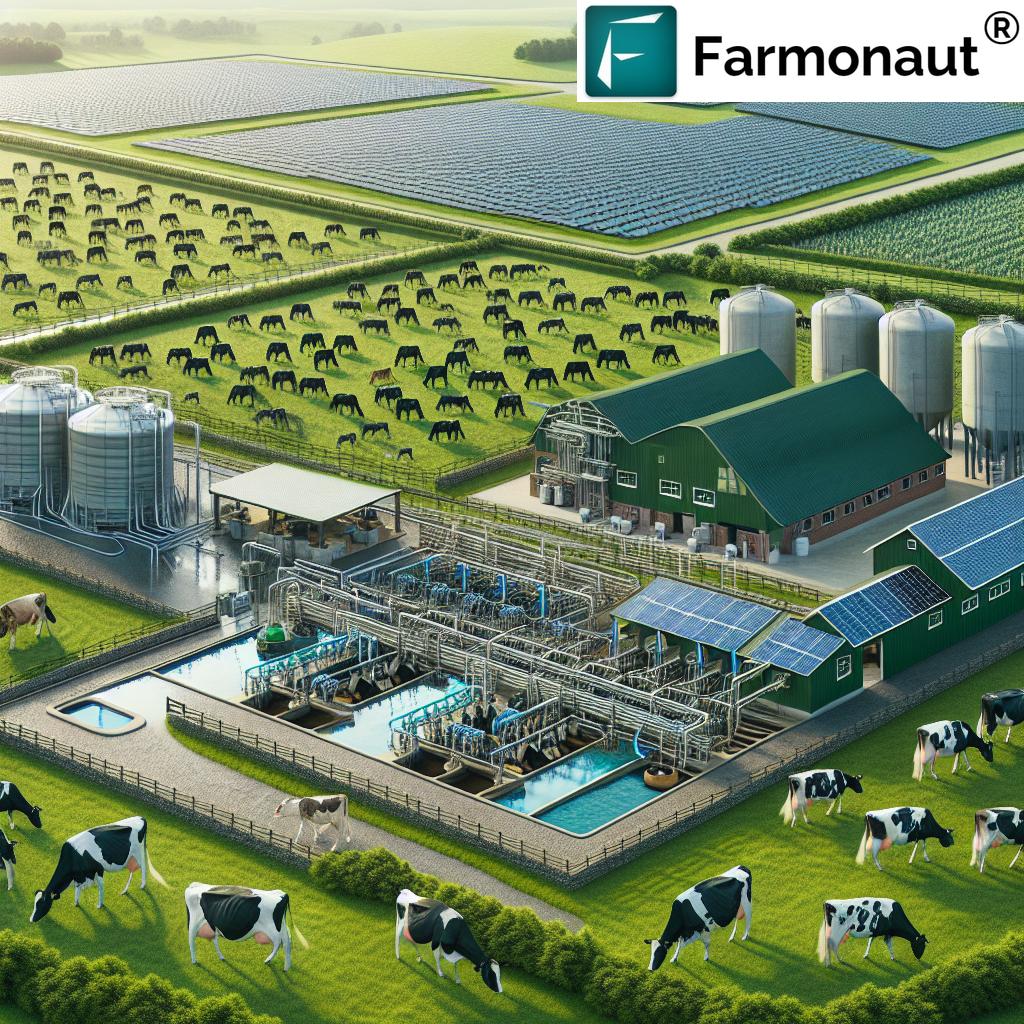How Tall Are Cotton Plants? Key Growth Factors For Optimal Yields
“Upland cotton plants typically reach 3-6 feet tall, while Pima cotton can grow up to 15 feet in ideal conditions.”
Table of Contents
- Introduction to Cotton Plant Height
- Cotton Species Variations and Typical Heights
- Cotton Species Height and Growth Factors Comparison Table
- Key Environmental Factors Affecting Cotton Growth
- Essential Agricultural Practices for Cotton
- Managing Cotton Plant Height in Cultivation
- How Farmonaut Supports Optimal Cotton Cultivation
- Frequently Asked Questions – Cotton Plant Height & Growth
- Conclusion: Optimizing Cotton Plant Height for Superior Yields
Introduction to Cotton Plant Height
Cotton is a fundamental staple in the textile industry worldwide, prized for its natural fiber and versatile properties. As farmers and agronomists seek optimal cultivation practices, one key question often arises: How tall do cotton plants grow? The answer isn’t as simple as a single measurement; cotton plant height is influenced by an intricate blend of species traits, environmental conditions, and agricultural practices.
Understanding the typical heights of these plants is crucial for effective harvesting, pest management, and attaining quality yields. In this comprehensive guide, we’ll explore cotton species variations, the major factors affecting cotton growth, and the best strategies for ensuring your cotton crop reaches its full potential.
Cotton Species Variations and Typical Heights
The genus Gossypium encompasses several distinct species, each with its unique growth habits and typical heights. When implementing cotton cultivation practices, recognizing the differences among these species is pivotal for achieving optimal plant height, maximizing fiber quality, and streamlining harvesting.
Let’s examine the primary cotton species grown worldwide, their morphological traits, and how each compares in stature.
Gossypium hirsutum (Upland Cotton): The Global Standard
Gossypium hirsutum, or Upland cotton, accounts for over 90% of global production. It is commonly found in the Americas, Africa, and Asia.
- Typical Height: 3 to 6 feet (1-2 meters) when cultivated under optimal conditions.
- Distinct Habits: Medium-height plants with a bushy structure, promoting efficient harvesting and high boll production.
- Why Favored: Adaptable to numerous environmental conditions and wide-ranging soil types.
Gossypium barbadense (Sea Island Cotton): Finer Fibers and Greater Height
Known for its extra-long, fine fibers, Gossypium barbadense is called Sea Island cotton. It is renowned throughout the Americas and Egypt for its quality.
- Typical Height: 3 to 10 feet (1-3 meters)—often forming a large bush or even a small tree in favorable settings.
- Distinct Habits: Generally taller and more expansive, with fewer but larger bolls.
- Uses: Prized in luxury textiles due to the long staple fibers.
Note: In extremely favorable environments with ample resources, rarely, Pima cotton (classified under barbadense types) has been recorded up to 15 feet, though this is not standard in commercial farming.
Gossypium arboreum (Tree Cotton): Native Resilience
Commonly grown across the Indian subcontinent, Gossypium arboreum exhibits strong resilience in rain-fed and challenging soil conditions.
- Typical Height: 3 to 6.5 feet (1-2 meters) tall.
- Distinct Habits: Often bushy, sometimes resembling a small tree when left in non-commercial setups.
- Benefits: Adapted to local pests and lower inputs but generally delivers a coarser fiber.
Additional Cotton Species
While the above dominate textile industry production, species like Gossypium herbaceum and wild relatives exist, but with less commercial importance and variable heights. Their growth patterns offer insight into cotton species variations globally.
Quick Comparison – Upland Cotton vs Sea Island Cotton
Comparing upland cotton vs sea island cotton highlights notable differences:
- Upland cotton is usually shorter and more manageable—ideal for mechanized harvests.
- Sea island cotton grows taller, with longer fibers but lower boll density per stem.
Cotton Species Height and Growth Factors Comparison Table
To help visualize critical differences and factors affecting cotton growth, the table below compares the most cultivated species:
| Cotton Species | Typical Plant Height (cm) | Growth Period (days) | Ideal Temperature (°C) | Optimal Rainfall (mm) | Notable Cultivation Practices |
|---|---|---|---|---|---|
| Gossypium hirsutum (Upland) | 100–200 | 160–220 | 24–29 | 500–1000 | Moderate fertilizer, optimal spacing (30–45cm), growth regulators like mepiquat chloride, irrigation during dry spells |
| Gossypium barbadense (Sea Island) | 100–300 (rarely up to 450) | 180–240 | 25–32 | 700–1200 | Wide spacing (45–60cm), pruning, high organic input, supplemental irrigation |
| Gossypium arboreum (Tree Cotton) | 100–200 | 140–200 | 22–28 | 400–950 | Suits rain-fed regions, minimal input, moderate fertilizer, adapted to poor soils |
Key Environmental Factors Affecting Cotton Growth
Cotton plant height is significantly influenced by environmental conditions. These factors determine not only how tall cotton plants grow, but also fiber quality, disease susceptibility, and ultimate yield.
Temperature: The Engine of Growth
Cotton thrives best in warm climates. Growth is most vigorous when temperatures remain within a favorable range:
- Optimal Range: 75°F to 85°F (24°C to 29°C).
- Thresholds: Growth slows below 65°F (18°C) and above 95°F (35°C), affecting both plant height and boll formation.
- Excessive Heat: Prolonged periods above 35°C can cause stunted plants due to increased respiration rates and moisture stress.
Sunlight: A Crucial Energy Source
The influence of sunlight on cotton plants cannot be overstated.
- Direct Sunlight Required: Minimum 6 hours per day is essential for healthy development and maximizing height.
- Fiber Quality: Sunlight exposure during flowering and boll development leads to more robust, fine fibers.
- Shaded Plants: Reduced light causes cotton to grow taller and spindly but with fewer, lower quality bolls.
Soil: Foundation of Plant Vigor
Cotton plants prefer well-drained soils:
- Soil Texture: Sandy loams or silty soils allow for deep root systems and stable growth.
- Soil pH: “Optimal soil pH for cotton growth is 5.8-8.0, directly impacting plant height and overall yield quality.”
- Compacts/Clays: Poor drainage leads to root rot and may cause stunted growth.
Water: Balancing Abundance and Scarcity
Water is another vital resource:
- Consistent Moisture: Required through the vegetative phase. Lack may cause stress and reduced height.
- Excessive Water: Saturation can lead to root rot and spindly, stunted plants. Well-planned irrigation is key in arid regions.
- Rainfall Needs: As little as 500mm per season (for hardy species) to 1200mm (for long-season cultivars).
Other Environmental Influences
- Wind: Excessive wind can damage tall varieties or cause lodging (bending of stalks), particularly in wider spaced or mature plantings.
- Disease Pressure: Fungal and bacterial pathogens thrive in overly damp and shaded conditions, reducing plant vigor and height.
Essential Agricultural Practices for Cotton
Beyond genetics and weather, agricultural practices for cotton directly impact plant height and quality. Choosing optimal conditions for cotton cultivation requires precision and adaptability.
Growth Regulators: Controlling Vertical Growth
Specialized substances like mepiquat chloride are used to check excessive vertical growth:
- Encourage efficient fruiting (boll development) over vegetative height.
- Reduce risk of long, slender (weak) plants that may lodge during storms.
- Essential in high-density plantings and high-fertility fields to maintain manageable heights for harvesting.
Pruning: Guiding Plant Energy
Pruning is the selective removal of lower branches and weak stalks:
- Focuses energy on productive growth points and boll setting.
- Often used in organic and hand-tended small plots.
- Reduces risk of pest and disease in dense canopies.
Planting Density and Spacing
Planting density and spacing are powerful levers in managing cotton plant height:
- Closer Spacing: Produces taller, slender plants that compete for light.
- Wider Spacing: Results in shorter, bushier plants with more branches and bolls per plant.
Practical Example: Impact of Spacing
- Closeness (20–30cm apart): More vertical, fewer side branches, easier mechanized harvest but can be more disease-prone due to denser canopy.
- Wider (40–60cm): Bushier, taller if unregulated, potentially higher yield per plant but more prone to wind damage.
Nutrient Management
- Adequate nitrogen, phosphorus, and potassium promote strong stem/leaf growth but excessive nitrogen may cause excessive vertical growth at the expense of fiber yield.
- Micronutrients (e.g., boron, zinc) also support proper cell division and plant architecture.
Weed and Pest Control
- Uncontrolled weeds compete for sunlight and water, leading to stunted or irregular growth.
- Integrated pest management helps reduce stress—pests can damage shoots, affecting height uniformity and quality.
Farmonaut’s AI Solutions for Crop Management
As a technology-driven agricultural advisory platform, Farmonaut offers real-time satellite crop monitoring, data-driven insights, and automated recommendations for critical crop health parameters, including optimal irrigation and nutrient management throughout vegetative and fruiting stages of cotton cultivation. Our Jeevn AI Advisory System delivers site-specific, actionable guidance to help farmers reach optimal plant height and fiber quality based on evolving field conditions throughout the season.
Additional Farmonaut Agricultural Services
-
Carbon Footprinting
– Track your farm’s environmental impact and make data-driven steps towards sustainable cotton production. -
Fleet and Resource Management
– Streamline your agricultural machinery, reducing operational costs and improving efficiency in cotton field management. -
Blockchain-Based Traceability Solutions – Guarantee transparency and trust throughout your cotton supply chain using Farmonaut’s traceability tools. -
Crop Loan and Insurance Support – Get satellite-based crop verification for more accessible and transparent crop finance and insurance.
Managing Cotton Plant Height for Healthier Yields
Managing cotton plant height is essential for maximizing yield and ensuring efficient harvesting. Here’s how farmers and agribusinesses can take control:
- Monitor Crop Growth Stages: Use satellite and drone imagery from Farmonaut to assess plant height development and spot areas of abnormal growth early—optimizing water and nutrient applications.
- Apply Growth Regulators Judiciously: Time applications to coincide with rapid vegetative expansion, especially in high-fertilizer fields.
- Choose Suitable Varieties: Select species best suited for your environmental conditions and planned agricultural practices.
- Adopt Flexible Planting Density: Base spacing decisions on field fertility, expected rainfall, and ability to manage taller stands.
- Pruning and Canopy Management: For tree or bushy cotton (e.g., arboreum types), prune after initial fruit set to encourage lateral branch development and a more manageable height.
- Monitor Weather Risks: High winds can damage taller plants; use windbreaks where necessary.
- Use Precision Ag Solutions: Platforms like Farmonaut combine satellite imagery with AI to deliver hyperlocal advice, helping you respond rapidly to environmental influences throughout the growing season.
Farmonaut API:
Integrate satellite crop and weather data directly into your agri-projects and apps for cotton field intelligence.
Developer Docs for API
– See how developers, co-operatives, and research organizations can leverage Farmonaut’s data grid.
How Farmonaut Supports Optimal Cotton Cultivation
We at Farmonaut are dedicated to making precision agriculture affordable and accessible for all farmers—from smallholders to large-scale producers—by offering data-driven tools that optimize every aspect of cotton production, from initial planting through to harvesting and supply chain traceability.
- Satellite Crop Health Monitoring: Track vegetation vigor (NDVI), moisture stress, and optimize field-level management for consistent plant height and yield maximization.
- AI-Based Advisory Systems (Jeevn AI): Receive real-time, localized insights for irrigation timing, fertilizer usage, and pest management. This enables farmers to respond rapidly to changing environmental conditions and avoid excessive water or nutrient applications that may stunt or encourage unwanted vertical growth.
-
Blockchain-Based Traceability: Our supply chain solutions empower you to document every stage of cotton’s journey, building consumer trust, especially where quality and ethical sourcing are prioritized.
Learn more about product traceability for the textile and garment industry. -
Fleet Management: Efficient logistics planning for field operations ensure resources are deployed when and where they’re needed most.
See how fleet management increases farm efficiency during cotton season. - Resource Management: Access carbon tracking, rainfall analysis, and operational planning for greener, sustainable cotton cultivation.
Our services help assure that your cotton crop—regardless of species or environmental conditions—reaches optimal height and quality for a profitable, sustainable future.
Frequently Asked Questions – Cotton Plant Height & Growth
1. How tall do cotton plants typically grow?
Most cultivated cotton species like Upland cotton (Gossypium hirsutum) grow 3–6 feet (1–2 meters) tall. Sea Island (G. barbadense) can occasionally reach up to 10–15 feet in ideal conditions, but commercial fields usually harvest at 3–8 feet for efficiency.
2. What species of cotton are best for taller growth?
Gossypium barbadense (Sea Island or Pima cotton) is genetically inclined to taller growth under optimal conditions. Tree cotton (G. arboreum) also attains greater heights when left unregulated.
3. What are the most important environmental requirements for cotton plants?
Warm temperatures (24–29°C), 6+ hours of direct sunlight daily, well-drained soil with pH 5.8-8.0, and average rainfall of 500–1200mm depending on variety. Consistent moisture and weed-free fields maximize height and fiber quality.
4. How can I manage plant height if my cotton is growing too tall or too short?
Use growth regulators (like mepiquat chloride) to check excessive vertical growth. Adjust planting density (closer spacing for taller, sparser plants and wider for bushier growth). Optimize irrigation and avoid over-fertilization with nitrogen.
5. How do modern technologies help monitor my cotton field’s growth stages and heights?
Farmonaut’s real-time satellite imagery delivers actionable data on plant vigor, suspected stunted areas, and overall health. AI-driven advisories help you counteract poor growth early for higher yields and stronger fiber quality.
6. Why does plant height matter in cotton production?
Appropriate cotton plant height ensures easier harvesting (especially mechanized), promotes higher boll yield, and can reduce pest/disease impacts. Excessive height may cause wind problems; stunted plants often underperform in both yield and fiber length.
7. Are there recommended practices for different species or regions, like the Indian subcontinent?
Absolutely. For Gossypium arboreum, used extensively in the Indian subcontinent, choose moderate spacings (30–45cm) and leverage minimal fertilizer approaches. Adapt irrigations and pest management as per local rainfall and soil conditions.
Conclusion: Optimizing Cotton Plant Height for Superior Yields
Cotton plant height is a critical, dynamic parameter shaped by intrinsic species characteristics, the environmental conditions imposed by climate and soil, and your chosen agricultural practices. Whether you’re deciding on upland cotton vs sea island cotton, tweaking planting density, or selecting the right growth regulators, a science-based approach leads to healthier, higher-quality yields.
By implementing the specific guidance outlined in this guide, as well as leveraging advanced platforms such as Farmonaut for data-driven decision making, every cotton producer can unlock greater efficiency, sustainability, and profitability in their fields—whether in the rolling cotton belts of the Indian subcontinent, American heartland, or arid reaches worldwide.
For real-time, actionable insights on managing cotton plant height and overall field health, try the Farmonaut app or reach out for API integration. Precision, reliability, and sustainability—all within your grasp.
Ready to advance your cotton cultivation? Monitor, analyze, and optimize with Farmonaut—the future of precision farming, powered by satellite, AI, and deep agri-data.


